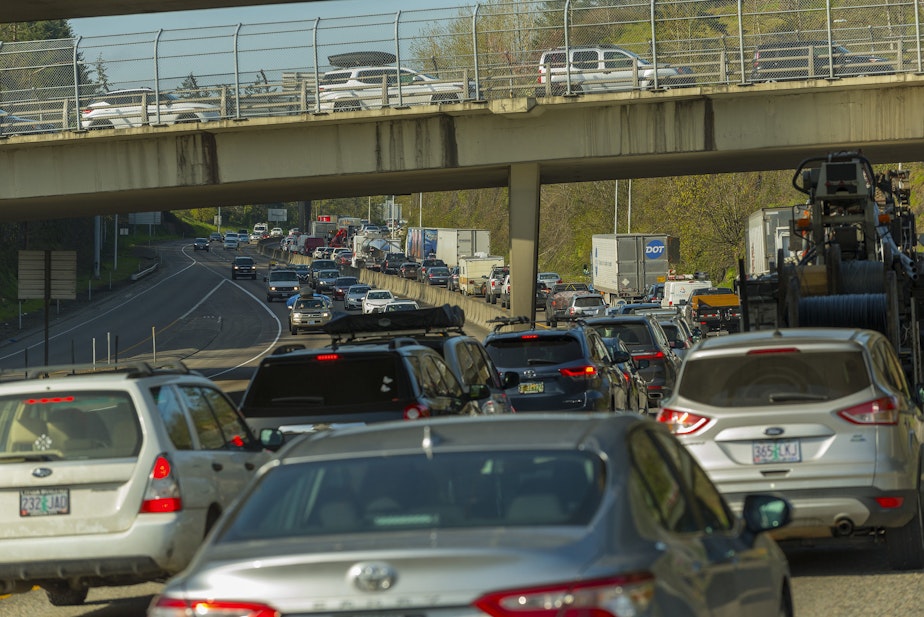Highway traffic has almost returned to pre-pandemic levels, but transit still way down

You're not imagining things if driving in Pacific Northwest traffic feels as busy these days as it was before the pandemic. Traffic data from the Oregon and Washington transportation departments show highway volumes are nearly back to 2019 levels.
Traffic monitored around the clock at 32 locations statewide by WSDOT during November 2021 was down four percent on average from the comparable period in 2019. Automatic traffic recorders at 38 locations across Oregon showed similar trends, with some places getting fully back to “normal” in some weeks as of this summer.
“In general, volumes are higher than last year and becoming very close to 2019 levels,” wrote ODOT senior economist Becky Knudson in a COVID-19 monitoring report. “However, volumes in the urban areas are relatively lower than the more rural areas.”
Daily traffic on Portland freeways is approaching pre-pandemic levels — 88 to 95 percent of 2019 daily traffic volumes, an ODOT spokesperson added.
So, what gives? The pandemic is ongoing and many people are still working from home. University of Washington expert Mark Hallenbeck, director of the Washington State Transportation Center, said part of the answer is that transit and carpool usage remains depressed.
Sponsored
"There's been a reluctance to go back to crowded transit conditions,” Hallenbeck said in an interview. “It's easier to hop in your car and go ahead and drive. It makes you feel safer."
Another reason for single-occupant cars to crowd the roads comes from the difficulty of syncing carpool schedules with newly popular hybrid schedules where people work from home part-time.
"It's really hard to carpool or vanpool when I'm working Tuesdays and Thursdays and you're working (in the office) Mondays and Wednesdays," Hallenbeck said. "So, that car pool doesn't exist anymore."
The ten biggest transit agencies in Washington state carried 40 to 50 percent fewer passengers on weekdays as of late summer than they did pre-pandemic, according to a WSDOT public transportation data dashboard. Ridership on Amtrak Cascades regional trains this autumn is down even more, around 60 percent below 2019.
Similarly in Oregon, ridership on Trimet's buses and light rail trains in October was about 53% of fall 2019's levels. At Cascades East Transit, which serves Central Oregon cities, ridership in November was about 50% of pre-pandemic levels. A CET outreach manager noted that bus service in Bend is currently reduced due to a shortage of drivers
Sponsored
The state-supported Amtrak Cascades service is slowly adding back trains to help ridership recover. Three roundtrips currently run between Seattle and Portland and there are two daily roundtrips on the Portland to Eugene segment. Amtrak Cascades passenger service north of Seattle to Vancouver, Canada, remains suspended.
Sponsored
From his office perch in a high rise in Seattle's University District, Hallenbeck can see southbound Interstate 5 choke up almost every afternoon. He observed that a dearth of central business district workers returning to their offices is leading traffic demand to come back unevenly.
"The biggest difference is that a.m. peak periods don't appear to be quite as strong as they used to be," Hallenbeck said. "The afternoon is much closer."
He said people who are working from home commonly go out in the afternoon to run errands and then mix with commuters to tip the freeway into a congested state.
Portland area freeways are showing the same morning-easier-than-afternoon pandemic travel pattern as Seattle, according to ODOT.
Hallenbeck said he is keeping an eye on the future of remote work and evolving hybrid work arrangements to anticipate what may happen next with traffic demand.
Sponsored
"Nobody really knows that answer," he said. "I actually spend as much time reading the business journals as I spend reading the transportation journals."
This story has been updated.
Copyright 2021 Northwest News Network

